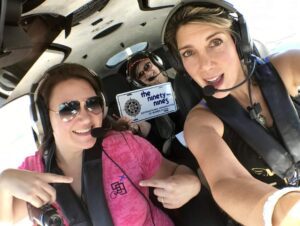 I think I should buy my own jet is a statement I hear often from many of our newly referred clients. Owning your own private jet or even a prop plane is a big endeavor for any person or business. Let’s look at the beginning for people interested in actually owning and flying their own plane or jet.
I think I should buy my own jet is a statement I hear often from many of our newly referred clients. Owning your own private jet or even a prop plane is a big endeavor for any person or business. Let’s look at the beginning for people interested in actually owning and flying their own plane or jet.
My wife, Katherine Koch, one of our managing partners will profess rent or charter first. She’s a private pilot that currently owns two prop planes and is working towards building the experience necessary for her ATP. Katie loves to fly! She earned her private pilot license before having a drivers license. She’s very active in the aviation industry and is the Chairperson for The Florida Goldcoast Chapter of The Ninety-Nines International. The Ninety-Nines is a non-profit charitable organization of women pilots from over 44 countries that promotes advancement of aviation through education, scholarships and mutual support. She constantly hears people say I think I should buy my own plane. I have often heard her ask potential pilots and business owners why they want to buy a plane. The top answers are they want to save money learning to fly or want to save money flying on their own or want to have their own jet for business purposes. She typically responds it is better to rent while learning because each license presents a different mission and you should always fly the plane that is most suitable for your mission. If you just love a certain plane and want to fly, do it, buy that plane and get going with your training. But if you think it will be less expensive to rent because you own, my friend you are very wrong. The same applies to purchasing a business jet, it is rare to have the same mission every flight. For example, you may need to transport key managers one day (suitable for a Honda Jet) and a team of 9 the next week (Gulfstream G500), or you may need to visit a remote office with an airport with a short runway one day and go into a major city the next. Regardless, chartering the flights until you know which aircraft best suit your mission and needs is definitely the way to go. If you’re looking to buy, charter first before considering a business jet purchase. Learning to fly, while rewarding, is not for everyone particularly if you wish to pilot a jet. Initial training includes private, instrument, commercial, and multi-engine. At an economic Part 141 school you can achieve this with about $75,000 and a year and a half with savings on both if you are dedicated full time to the endeavor. You then will need to get a type rating for the specific aircraft. If your aircraft or insurance require an ATP rating, you need to build a minimum of 1500 hours, about 1200 additional hours, in order to meet ATP minimums. If you build this time by working full time (for peanuts) at a very busy flight school you can build this time in about a year, but it likely will take longer if you have other obligations in your life.
Regardless of what type of plane or jet you may be interested in buying, there are many costs involved. Aircraft values have increased significantly in the past few years and it is still a seller’s market. It is necessary to have a pre-buy inspection performed by a reputable shop. There are many upfront fees and payment of taxes to consider. Once you purchase the plane, a safety conscious owner will inevitably invest in a good deal of maintenance to ensure the previous owner didn’t overlook anything. Then you have the cost of storage. Depending on where you live, finding a space outside on the ramp or inside a hangar can be both difficult and expensive, some areas have waiting lists for their hangars. Using a tie down at the local airport sounds cheap enough until you consider the deterioration caused by exposure to weather and uv rays causing higher repair costs and down time, greater likelihood of theft and collision, or, as we spoke about recently, a tornado decides to rip your investment in half like many experienced when Hurricane Ian visited Florida. In South Florida, it is very difficult to find hangar space for a small plane and even more rare to find hangar space for a larger aircraft or jet. Then you have maintenance costs to consider. Private piston planes and jets don’t have simple scheduled oil changes and tire rotations like you do for your Porsche 911. They are annually brought back to a standard near new condition to make sure you are safe to fly it. There are no cost cutting moves or coupons to reduce your bill. And you can’t do them yourself. They must be performed by a very well trained Airframe & Powerplant (A&P) mechanic and the work must be signed off by an A&P with Inspection Authorization (IA). Ideally, a reputable Part 145 repair station with oversight from the FAA Flight Standards District Office (FSDO) will perform the work. If minimal work is needed on a just a small piston plane, the annuals are several thousands of dollars. When it comes time for engine overhauls, propeller overhauls, undercarriage overhauls, or non-destructive testing, for example, the invoices soar while you remain grounded waiting on the work. With current parts shortages the lead times can be months and in some cases over a year. For jets, they have very expensive overhauls scheduled on time limits as well as depending on usage. One of our customers purchased a jet for the family to go between their homes in the US and Europe only to have a medical issue followed by pandemic closures essentially ground their plane. Despite very little use, they had to perform overhauls costing several hundred thousand dollars because of the time that passed. Needless to say the customer is looking to sell the family jet now and continue chartering with us. Further, many manufacturers only recognize certain repair stations so you may need to take the plane to four different shops spread out throughout the US to have the required maintenance performed. Often these specialty repair stations have waiting lists so planning becomes paramount. For this and many other reasons many jet owners use maintenance management companies to avoid the daily headaches. Another overlooked cost is insurance. If you plan to fly your plane you may be limited as to which aircraft you can be insured to fly. For example, insurance for our larger plane requires a certain number of total hours, a certain number of hours for that type of landing gear, a certain number of hours in that model, and an instrument rating all for the privilege of being able to purchase insurance. Insurance for jets is naturally a higher barrier. You have insurance which will cover liability and hull insurance to cover the replacement cost of a plane. Incredibly long story short: Renting or chartering will be the best option for anyone planning to fly their own plane or jet for sure until ownership is a desire not a cost savings idea.
Next week we will turn our attention to the business purchase of a Jet.
Until then, Be Social, Fly Private! Sign Up Today Follow us on Instagram Follow us on Facebook

 Private Flying Rules: FAA Part 91, 121, 135. There are numerous rules and regulations governing all air travel, but let’s take a look at the three most of us fly under. FAA Part 121, covering Domestic, Flag and Supplemental Operations, is the most familiar as it is what all commercial airlines fly under including the major airlines and the regionals. Since we focus primarily on private air travel, charter, emptylegs, et cetera, we will most likely be flying under FAA Part 135 and in our own planes, FAA part 91.
Private Flying Rules: FAA Part 91, 121, 135. There are numerous rules and regulations governing all air travel, but let’s take a look at the three most of us fly under. FAA Part 121, covering Domestic, Flag and Supplemental Operations, is the most familiar as it is what all commercial airlines fly under including the major airlines and the regionals. Since we focus primarily on private air travel, charter, emptylegs, et cetera, we will most likely be flying under FAA Part 135 and in our own planes, FAA part 91.  When we need to get out of harms way. Hurricane Ian’s insured losses continue to mount. Estimated losses are ranged from 53 to 74 billion dollars from Florida to the Carolinas. The modeling firm, RMS *, estimates that the damage will be very close to $67 billion in insured losses. These figures will rank Hurricane Ian as the All-Time costliest storms to hit Florida and place it 2nd only to Hurricane Katrina nationally as pertaining to insured losses. Densely populated areas such as Naples, Ft. Myers, and the barrier Island Sanibel were devastated and the death toll has already surpassed 100 souls**.
When we need to get out of harms way. Hurricane Ian’s insured losses continue to mount. Estimated losses are ranged from 53 to 74 billion dollars from Florida to the Carolinas. The modeling firm, RMS *, estimates that the damage will be very close to $67 billion in insured losses. These figures will rank Hurricane Ian as the All-Time costliest storms to hit Florida and place it 2nd only to Hurricane Katrina nationally as pertaining to insured losses. Densely populated areas such as Naples, Ft. Myers, and the barrier Island Sanibel were devastated and the death toll has already surpassed 100 souls**. Hurricane Ian will go down in history as one of the worst storms to impact the state of Florida in decades. It devastated the west coast of Florida with near Category 5 winds, torrential and unrelenting rain, plus a whopping 12+ ft storm surge. Like its predecessor, Hurricane Andrew, it caused death and destruction in the billions of dollars. 30 years ago, Hurricane Andrew caused 50 billion in damage, destroyed 60,000 homes, and left 170,000 people homeless. We haven’t had enough time to tally the pain caused by Hurricane Ian, but I’m sure the numbers will dwarf those of Andrew. Most of the areas hit were swamps and mangroves back in the early 1900s until men like Carl Fisher and Henry Flagler etched out their respective fortunes turning these same natural landscapes into concrete and coral stone. We no longer have the protection from mother nature’s palm trees, everglades, and mangroves to protect us. Although newer multi-million dollar homes and buildings are engineered with strength to endure these natural disasters, they seem not as well suited for battle as these weather events get more and more powerful with our ever changing climate and environment.
Hurricane Ian will go down in history as one of the worst storms to impact the state of Florida in decades. It devastated the west coast of Florida with near Category 5 winds, torrential and unrelenting rain, plus a whopping 12+ ft storm surge. Like its predecessor, Hurricane Andrew, it caused death and destruction in the billions of dollars. 30 years ago, Hurricane Andrew caused 50 billion in damage, destroyed 60,000 homes, and left 170,000 people homeless. We haven’t had enough time to tally the pain caused by Hurricane Ian, but I’m sure the numbers will dwarf those of Andrew. Most of the areas hit were swamps and mangroves back in the early 1900s until men like Carl Fisher and Henry Flagler etched out their respective fortunes turning these same natural landscapes into concrete and coral stone. We no longer have the protection from mother nature’s palm trees, everglades, and mangroves to protect us. Although newer multi-million dollar homes and buildings are engineered with strength to endure these natural disasters, they seem not as well suited for battle as these weather events get more and more powerful with our ever changing climate and environment.